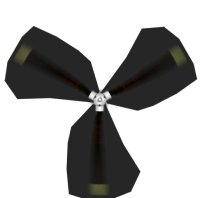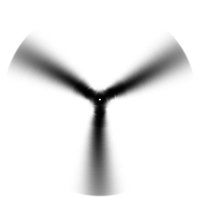
|
|
Example
This is an example (downsized) of how the blurred color texture can look like after the above steps.
|
Create blurred alpha (transparency) texture
- Use the same original propeller render (the one from the front)
- Turn it into grayscale
- Maximize contrast (your image should now only have 2 colors - black and white)
- Apply a radial blur (you'll have to experiment with the amount)
- Your blurred alpha map should have wider blades than the original propeller render (3-4 times wider)
 |

|
|
Example
This is an example (downsized) of how the blurred alpha texture can look like after the above steps. The blades in this example are actually not wide enough.
|
Create your blurred propeller
- Create a disc in your 3D application
- Apply the blurred color texture in the color channel
- Apply the blurred alpha map in the alpha/transparency channel (you may need to invert it in some applications)
- Play around with transparency and blur amount until you're satisfied with how the render looks
Cons and pros compared to using motion blur
- Pro: easier to control
- Con: Propeller may look flat when looking from the side
|


